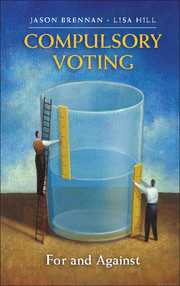Book contents
- Frontmatter
- Contents
- Acknowledgments
- Part I Medicine Worse Than the Disease?
- Part II Compulsory Voting Defended
- 5 Compulsory Voting: Background, Effects, Feasibility, and Basic Premises
- 6 Turnout, Abstention, and Democratic Legitimacy
- 7 Is Compulsory Voting an Unjustified Burden on Personal Autonomy?
- 8 Is Requiring People to Vote Contrary to Democratic Values?
- 9 Conclusion
- Bibliography
- Index
- References
6 - Turnout, Abstention, and Democratic Legitimacy
Published online by Cambridge University Press: 05 June 2014
- Frontmatter
- Contents
- Acknowledgments
- Part I Medicine Worse Than the Disease?
- Part II Compulsory Voting Defended
- 5 Compulsory Voting: Background, Effects, Feasibility, and Basic Premises
- 6 Turnout, Abstention, and Democratic Legitimacy
- 7 Is Compulsory Voting an Unjustified Burden on Personal Autonomy?
- 8 Is Requiring People to Vote Contrary to Democratic Values?
- 9 Conclusion
- Bibliography
- Index
- References
Summary
Introduction
Before embarking on a specific defense of the requirement to vote, it is important to discuss the problem to which compulsory voting is a purported solution: low voter turnout. As Ben Saunders has pointed out, “If high turnout is not necessarily democratically better than low levels of turnout, then compulsory voting cannot be justified on the grounds that it is necessary to realize democracy.”
Despite the assumed importance of elections and voting, some commentators have argued that it is not necessary – or even desirable – for everyone to vote and that low turnout therefore presents no problems for democracy or democratic legitimacy. Is there actually anything wrong with low turnout? Can democracy really do without voters? And can we, as individuals, do without voting?
Before starting, it may be worth clarifying what this chapter is not about: it is not about whether aggregative democracy is superior or inferior to other forms of democracy (such as deliberative democracy) as a means for preference gathering and self-government; further, it is not about which voting system best serves democratic values. Neither does it challenge the idea that voting is self-defeating because of the ambiguities and instabilities that can plague voting methods (as per William Riker and Kenneth Arrow). Rather, it takes the following as facts of political life that must be taken into account rather than wished away: namely, that voting – with all its distortions and problems – remains the primary mechanism for establishing legitimate governments in advanced representative democracies and, further, that things are likely to stay this way for the foreseeable future. Given this reality, does low turnout matter?
- Type
- Chapter
- Information
- Compulsory VotingFor and Against, pp. 125 - 153Publisher: Cambridge University PressPrint publication year: 2014



